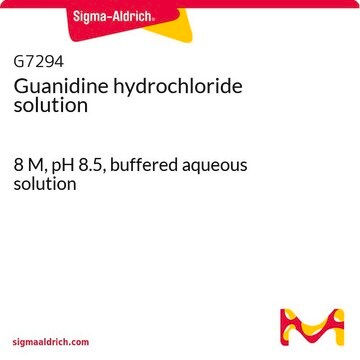50933
Guanidine hydrochloride
BioUltra, for molecular biology, ≥99.5% (AT)
Synonym(s):
Aminoformamidine hydrochloride, Aminomethanamidine hydrochloride, Guanidinium chloride
About This Item
Recommended Products
biological source
synthetic
grade
for molecular biology
product line
BioUltra
Assay
≥99.5% (AT)
form
powder or crystals
technique(s)
RNA extraction: suitable
impurities
DNases, none detected
RNases, none detected
insoluble matter, passes filter test
phosphatases, none detected
proteases, none detected
ign. residue
≤0.05% (as SO4)
loss
≤0.05% loss on drying, 20 °C (HV)
color
colorless to white,
pH
4.5-6.0 (25 °C, 6 M in H2O)
mp
180-185 °C (lit.)
solubility
H2O: 6 M at 20 °C, clear, colorless
density
1.3 g/cm3 (lit.)
anion traces
sulfate (SO42-): ≤50 mg/kg
cation traces
Al: ≤5 mg/kg
As: ≤0.1 mg/kg
Ba: ≤5 mg/kg
Bi: ≤5 mg/kg
Ca: ≤10 mg/kg
Cd: ≤5 mg/kg
Co: ≤5 mg/kg
Cr: ≤5 mg/kg
Cu: ≤5 mg/kg
Fe: ≤5 mg/kg
K: ≤50 mg/kg
Li: ≤5 mg/kg
Mg: ≤5 mg/kg
Mn: ≤5 mg/kg
Mo: ≤5 mg/kg
Na: ≤150 mg/kg
Ni: ≤5 mg/kg
Pb: ≤5 mg/kg
Sr: ≤5 mg/kg
Zn: ≤5 mg/kg
SMILES string
Cl[H].NC(N)=N
λ
6 M in H2O
UV absorption
λ: 260 nm Amax: 0.03
λ: 280 nm Amax: 0.02
storage temp.
room temp
InChI
1S/CH5N3.ClH/c2-1(3)4;/h(H5,2,3,4);1H
InChI key
PJJJBBJSCAKJQF-UHFFFAOYSA-N
Gene Information
human ... KCNA1(3736) , KCNA10(3744) , KCNA2(3737) , KCNA3(3738) , KCNA4(3739) , KCNA5(3741) , KCNA6(3742) , KCNA7(3743) , KCNB1(3745) , KCNB2(9312) , KCNC1(3746) , KCNC2(3747) , KCNC3(3748) , KCNC4(3749) , KCND1(3750) , KCND2(3751) , KCND3(3752) , KCNF1(3754) , KCNG1(3755) , KCNG2(26251) , KCNG3(170850) , KCNG4(93107) , KCNH1(3756) , KCNH2(3757) , KCNH3(23416) , KCNH4(23415) , KCNH5(27133) , KCNH6(81033) , KCNH7(90134) , KCNH8(131096) , KCNQ1(3784) , KCNQ2(3785) , KCNQ3(3786) , KCNQ4(9132) , KCNQ5(56479) , KCNS1(3787) , KCNS2(3788) , KCNS3(3790) , KCNV1(27012) , KCNV2(169522)
Looking for similar products? Visit Product Comparison Guide
General description
Application
Biochem/physiol Actions
Signal Word
Warning
Hazard Statements
Precautionary Statements
Hazard Classifications
Acute Tox. 4 Inhalation - Acute Tox. 4 Oral - Eye Irrit. 2 - Skin Irrit. 2
Storage Class Code
11 - Combustible Solids
WGK
WGK 1
Flash Point(F)
Not applicable
Flash Point(C)
Not applicable
Personal Protective Equipment
Certificates of Analysis (COA)
Search for Certificates of Analysis (COA) by entering the products Lot/Batch Number. Lot and Batch Numbers can be found on a product’s label following the words ‘Lot’ or ‘Batch’.
Already Own This Product?
Find documentation for the products that you have recently purchased in the Document Library.
Customers Also Viewed
Articles
A RPLC-MS workflow for mass analysis of reduced monoclonal antibody, trastuzumab, including reduction procedures, calibration, and system suitability tests.
A RPLC-MS workflow for mass analysis of reduced monoclonal antibody, trastuzumab, including reduction procedures, calibration, and system suitability tests.
A RPLC-MS workflow for mass analysis of reduced monoclonal antibody, trastuzumab, including reduction procedures, calibration, and system suitability tests.
A RPLC-MS workflow for mass analysis of reduced monoclonal antibody, trastuzumab, including reduction procedures, calibration, and system suitability tests.
Related Content
Overview of common techniques and downstream applications for extraction and purification of genomic DNA, plasmid DNA, and total RNA from cells, tissue, blood, viruses, and other sample types.
Overview of common techniques and downstream applications for extraction and purification of genomic DNA, plasmid DNA, and total RNA from cells, tissue, blood, viruses, and other sample types.
Overview of common techniques and downstream applications for extraction and purification of genomic DNA, plasmid DNA, and total RNA from cells, tissue, blood, viruses, and other sample types.
Overview of common techniques and downstream applications for extraction and purification of genomic DNA, plasmid DNA, and total RNA from cells, tissue, blood, viruses, and other sample types.
Our team of scientists has experience in all areas of research including Life Science, Material Science, Chemical Synthesis, Chromatography, Analytical and many others.
Contact Technical Service


